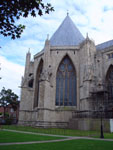 The
Chapter House of York Minster and its vestibule stand as a high point in
English architectural design. Built during the 1280s under Archbishop John
Romeyn (1286-96), the Chapter House was swiftly completed and by 1291 work
was underway on the Minster's nave. The
Chapter House of York Minster and its vestibule stand as a high point in
English architectural design. Built during the 1280s under Archbishop John
Romeyn (1286-96), the Chapter House was swiftly completed and by 1291 work
was underway on the Minster's nave. 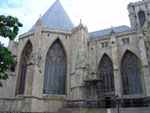 The
Chapter House's octagonaldesign is achieved without a central column, a
tour-de-force of engineering skill and aesthetic grace. Seven sides of the
buildings are glazed with five-lancet windows, each with tracery lights
of three multi-lobed circles. A series of seats long the walls served as
places for each of the cannons. Significantly, the archbishop was not a
member of the chapter, and did not have a seat. The
Chapter House's octagonaldesign is achieved without a central column, a
tour-de-force of engineering skill and aesthetic grace. Seven sides of the
buildings are glazed with five-lancet windows, each with tracery lights
of three multi-lobed circles. A series of seats long the walls served as
places for each of the cannons. Significantly, the archbishop was not a
member of the chapter, and did not have a seat.
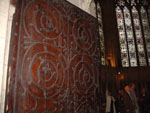 The
vestibule of the chapter house, where Kempe waited for her interview,
shows an elegantly arched entrance with two doors, surviving with their
late 13th-century ironwork. The
vestibule of the chapter house, where Kempe waited for her interview,
shows an elegantly arched entrance with two doors, surviving with their
late 13th-century ironwork. 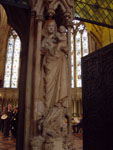 In
the center, the statue of the Virgin holds her child. Since the statue
is carved with the stone block behind it, if proved difficult to iconoclasts
to removed. Above the vestibule is a second-story loft built to serve
as a planning site for subsequent construction of the cathedral. It is
known today as the masons' loft and contains original timber roof dating
before 1290. The major feature of the loft is a long rectangular room
where templates - exact size drawings - were prepared for the laying out
of windows In
the center, the statue of the Virgin holds her child. Since the statue
is carved with the stone block behind it, if proved difficult to iconoclasts
to removed. Above the vestibule is a second-story loft built to serve
as a planning site for subsequent construction of the cathedral. It is
known today as the masons' loft and contains original timber roof dating
before 1290. The major feature of the loft is a long rectangular room
where templates - exact size drawings - were prepared for the laying out
of windows  and
other elements of stonework. Tracings corresponding to windows in the
Minster have been uncovered; a protective second floor now preserves these
markings. and
other elements of stonework. Tracings corresponding to windows in the
Minster have been uncovered; a protective second floor now preserves these
markings.
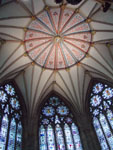 The
modern viewer now sees only the windows in their bright color but in Margery
Kempe's time all wall surfaces were treated with some form of decoration.
Indeed the Chapter House was one of the richest areas of the entire Minster
- comparable to the combination of stained glass, painted walls, sculpture,
and enamels that can be seen in the Sainte-Chapelle of Paris of 1243-48.
Above the door, the blind tracery was painted as if it were a window,
presenting kings and bishops, as recorded in a drawing of the Chapter
House about 1795 by Joseph Halfpenny. Below were depicted Christ and the
twelve apostles. The ribs and the vaults were also colored, apparently
similar to their 19th-century The
modern viewer now sees only the windows in their bright color but in Margery
Kempe's time all wall surfaces were treated with some form of decoration.
Indeed the Chapter House was one of the richest areas of the entire Minster
- comparable to the combination of stained glass, painted walls, sculpture,
and enamels that can be seen in the Sainte-Chapelle of Paris of 1243-48.
Above the door, the blind tracery was painted as if it were a window,
presenting kings and bishops, as recorded in a drawing of the Chapter
House about 1795 by Joseph Halfpenny. Below were depicted Christ and the
twelve apostles. The ribs and the vaults were also colored, apparently
similar to their 19th-century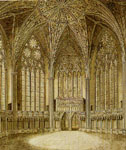 Victorian design seen today. A series of large single figures painted
on wood were originally set into the lower segments of vaults, now painted
white. Descriptions allow us to identify St. Peter,
Victorian design seen today. A series of large single figures painted
on wood were originally set into the lower segments of vaults, now painted
white. Descriptions allow us to identify St. Peter,  St.
Paul, probably St. William, St. Edmund, St. John the Baptist, St. Catherine,
Moses, Mary Magdalene, and the allegorical figures of the Church and the
Synagogue. The image of the Synagogue is still largely intact and a few
other important fragments remain. St.
Paul, probably St. William, St. Edmund, St. John the Baptist, St. Catherine,
Moses, Mary Magdalene, and the allegorical figures of the Church and the
Synagogue. The image of the Synagogue is still largely intact and a few
other important fragments remain.
Clearly the building was made
in impress, showing the power of the cathedral clergy through images of
Moses as giver of the Law and the Church, now supplanting the Synagogue,
continuing Moses's power. Peter and Paul were patrons of the cathedral,
William was the York bishop whose shrine Margery Kempe had come to venerate,
and Edmund was the king and martyr killed by the Danes. These saints appear
again in the window cycles. The central window, opposite the entrance,
is dedicated to the Passion of Christ, followed o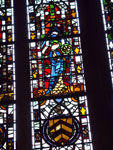 n
the north by windows dedicated to the Virgin Mary, St. William, and, closest
to the entrance, St. Catherine. To the south are St. Peter, St. Paul,
and then a window with five saints, Thomas Becket, Margaret, Nicholas,
John the Baptist, and Edmund, their stories told in each of the five lancets.
All of the windows also show shields of arms in their tracery light, subjects
that would be highly identifiable to a medieval viewer. Likewise, the
vestibule was richly decorated with painted walls and windows showing
rulers, clergy, and saints. n
the north by windows dedicated to the Virgin Mary, St. William, and, closest
to the entrance, St. Catherine. To the south are St. Peter, St. Paul,
and then a window with five saints, Thomas Becket, Margaret, Nicholas,
John the Baptist, and Edmund, their stories told in each of the five lancets.
All of the windows also show shields of arms in their tracery light, subjects
that would be highly identifiable to a medieval viewer. Likewise, the
vestibule was richly decorated with painted walls and windows showing
rulers, clergy, and saints.
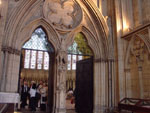 The
Chapter House was one of the most public locations within the cathedral.
Serving the cathedral clergy as a site of business deliberation, the building
was secular enough to serve as a venue for a meeting of Parliament in
1296. In book 51 Kempe describes how a priest who "seemed a respected
cleric" had asked her how long she would remain in York and commanded
her to appear before him in the Chapter House. On the day of her appearance,
she had friends to support her and a priest came through the busy area
to take her by arm to lead her into the Chapter House. One can imagine
the press of a crowd in the spaces in the vestibule and Kempe waiting
until the doors were open. Doors were unusual in chapter house architecture.
York apparently needed doors to seal off the discussions from the busy
activity in the north transept and vestibule. She notes that many other
clergy were there and when asked the reason for her visit she replied
that she had come to venerate the shrine of St. William. After examining
her on the articles of faith, they demanded that she be examined by the
Archbishop of York at the Episcopal residence at Cawood, just south of
York. The
Chapter House was one of the most public locations within the cathedral.
Serving the cathedral clergy as a site of business deliberation, the building
was secular enough to serve as a venue for a meeting of Parliament in
1296. In book 51 Kempe describes how a priest who "seemed a respected
cleric" had asked her how long she would remain in York and commanded
her to appear before him in the Chapter House. On the day of her appearance,
she had friends to support her and a priest came through the busy area
to take her by arm to lead her into the Chapter House. One can imagine
the press of a crowd in the spaces in the vestibule and Kempe waiting
until the doors were open. Doors were unusual in chapter house architecture.
York apparently needed doors to seal off the discussions from the busy
activity in the north transept and vestibule. She notes that many other
clergy were there and when asked the reason for her visit she replied
that she had come to venerate the shrine of St. William. After examining
her on the articles of faith, they demanded that she be examined by the
Archbishop of York at the Episcopal residence at Cawood, just south of
York.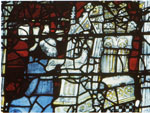 The following day she was taken by a good man and his wife the "7
miles" to Cawood for her interview with Archbishop Henry Bowet (1407-23).
The following day she was taken by a good man and his wife the "7
miles" to Cawood for her interview with Archbishop Henry Bowet (1407-23).
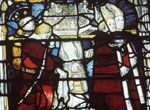 The
shrine mentioned by Kempe was that of Archbishop William of York, whose
body was transferred from his tomb in the Minster's nave to the choir
in 1284 (the shrine was replaced in 1472 by a larger structure now surviving
in remnants). At the time of Kempe's visit to the shrine of St. William,
an extraordinary window had just been completed nearing its completion.
In one of the most brilliant accomplishments of the cathedral, 95 panels
narrate the The
shrine mentioned by Kempe was that of Archbishop William of York, whose
body was transferred from his tomb in the Minster's nave to the choir
in 1284 (the shrine was replaced in 1472 by a larger structure now surviving
in remnants). At the time of Kempe's visit to the shrine of St. William,
an extraordinary window had just been completed nearing its completion.
In one of the most brilliant accomplishments of the cathedral, 95 panels
narrate the life of St. William and the many miracles accomplished at his tomb. The
donor of the window was presumably Beatrice de Ross (d. 1415) the mother
of William sixth Baron Rosof Helmsley, long associated with the construction
of the cathedral. Images of stained glass are courtesy Crown Copyright.
life of St. William and the many miracles accomplished at his tomb. The
donor of the window was presumably Beatrice de Ross (d. 1415) the mother
of William sixth Baron Rosof Helmsley, long associated with the construction
of the cathedral. Images of stained glass are courtesy Crown Copyright.
York, Chapter House, 1280s, Entrance. ©Raguin
MMK
York,
Chapter House, 1280s, Seats long the walls. ©Raguin MMK
York,
Chapter House, 1280s, rear of entrance wall showing blind tracery
that was originally painted to look like the windows. ©Raguin MMK
|


 The
Chapter House of York Minster and its vestibule stand as a high point in
English architectural design. Built during the 1280s under Archbishop John
Romeyn (1286-96), the Chapter House was swiftly completed and by 1291 work
was underway on the Minster's nave.
The
Chapter House of York Minster and its vestibule stand as a high point in
English architectural design. Built during the 1280s under Archbishop John
Romeyn (1286-96), the Chapter House was swiftly completed and by 1291 work
was underway on the Minster's nave.  The
Chapter House's octagonaldesign is achieved without a central column, a
tour-de-force of engineering skill and aesthetic grace. Seven sides of the
buildings are glazed with five-lancet windows, each with tracery lights
of three multi-lobed circles. A series of seats long the walls served as
places for each of the cannons. Significantly, the archbishop was not a
member of the chapter, and did not have a seat.
The
Chapter House's octagonaldesign is achieved without a central column, a
tour-de-force of engineering skill and aesthetic grace. Seven sides of the
buildings are glazed with five-lancet windows, each with tracery lights
of three multi-lobed circles. A series of seats long the walls served as
places for each of the cannons. Significantly, the archbishop was not a
member of the chapter, and did not have a seat.